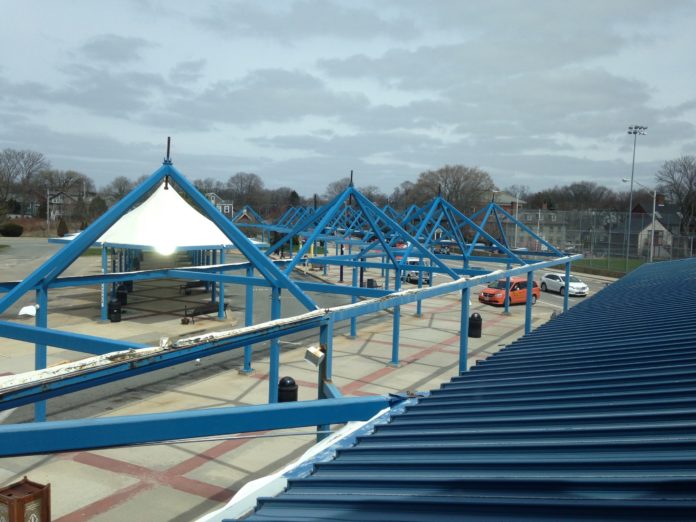
The Blackstone Valley Visitor Center in Pawtucket has a historical timeline of the valley on the wall, a 90-seat theater showing a film about the region and a large, walkable floor map.
Over the years, as the recession forced budgets cuts, centers like this one were often eliminated. In Rhode Island, for example, the roadside Interstate 95 visitor center between exit 2 and exit 3 fell victim to the stagnant economy, says Evan Smith, president and CEO of Discover Newport.
But the impact of budget cuts and the lure of online travel planning have not been so sweeping as to obviate the need for the personal contact, gateway accessibility, convenience and firsthand information staff and amenities at visitor centers can provide, say Smith and others involved in their operation.
The floor map, which pinpoints riverboat locations on the Blackstone River, mill buildings in old mill towns, bike trails and other historic sites, is popular with schoolchildren and tourists alike, said Wendy Jencks, the Blackstone Valley Visitor Center manager.
“Our location says a lot about why we’re here,” said Jencks, “because the Slater Mill historic site is right across the street and that’s considered the beginning of the Industrial Revolution. We are a gateway to Rhode Island, a southern gateway to the Blackstone Valley, and we do a service to the city.
“People will stop here and get information about the Paw Sox, local restaurants [and] parks, so it’s good for the city, the state, the whole region,” she said.
Smith, who admitted to being “obsessed” with visitor centers and their continued viability, reached out to lawmakers and recently helped procure $1.6 million in federal aid in March that will go toward installing roofs where there once were tented coverings at The Newport Visitor Information Center.
Larger than many welcome centers, the Newport center is a place where railroad and bus transit routes converge, and operates in partnership with R.I. Public Transit Authority to cover costs.
“On a busy Friday, we can make 300 lodging reservations through the visitor center,” Smith said. People will come to see the Breakers mansion, planning to spend $30 a ticket, but after learning about the International Tennis Hall of Fame and historic Fort Adams through the center, end up expanding their visit, staying to eat and shop, even, perhaps indulging in an unplanned overnight, he said.
Traffic at visitor centers and welcome centers varies widely, but is not insignificant, managers contend.
Blackstone Valley’s Pawtucket center sees about 81,000 travelers a year, while its sister site off of Interstate 295 handles about 100,000 visitors, said Natalie Carter, director of operations for the Blackstone Valley Tourism Council.
At the other extreme, the Newport center serves 600,000 people a year, Smith said.
Much smaller numbers – in the low thousands – are registered at the Block Island visitor center managed by the Block Island Tourism Council, said council Executive Director Jessica Willi.
Use of the South County Tourism Council’s visitor center within its offices at 4808 Tower Hill Road – which is accessible around the clock, but it is not affiliated with R.I. Public Transit Authority – is growing, said Myrna George, council president and CEO, in an email, along with online tourism.
The council also has developed visitor information center criteria with the six chambers of commerce throughout its 449-square-mile region, designed and built a historically accurate Welcome to South County Visitor Information stand at the Kingston Station and provides South County Visitor Information at the Wickford Train Station, she said.
And the Providence Warwick Convention & Visitors Bureau, which handles visitors at both the R.I. Convention Center and a satellite center in the GTECH Corp. building downtown, responded to 21,333 visitor inquiries via emails, phone calls and walk-ins during the 2012-13 fiscal year, said Kristen Adamo, the bureau’s vice president of marketing and communications.
“Everybody does have access to online services, but most of the visitors I see have disposable income to tour the country and state at their leisure,” she said.
Smith founded the New England Visitor Center Association, currently overseen by interim Chairman Bill Pickles, a Massachusetts representative. The association is intended to support best practices in the industry and serves anyone interested, as well as several hundred visitor centers, Pickles said.
Services provided by visitor centers include brochures, maps, kiosks, as well as rest rooms, in some cases vendors, and other amenities. In 2012, the Maria Miles Visitor Information Center in Salisbury, Mass., served more than 500,000 people, he said.
“Visitor centers are still tremendously popular because it’s one place where you can walk in and find out information on the local area,” he said. “What has happened is they have adopted the computer technology. They have computers, Wi-Fi: You can find information that would take you hours and hours to find on the Internet. Plus, you talk [with staff] firsthand and get a much better grasp than you can just looking on your cellphone.”
In Newport, Smith says the next generation of visitor centers is going to look and feel more like an attraction and be multidimensional.
“They’re not just going to be roadside stops where you go to the bathroom and get a map,” he said. “The visitor center for the next 25 years has got to have exhibits, kiosks. The direction we’re heading in is: people are either closing them or upgrading them. We’re upgrading them.” •












